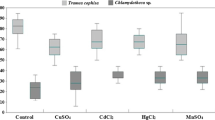Abstract
A mayfly,Ephemerella grandis, and a stonefly,Pteronarcys californica, were exposed to lead, zinc, copper, and silver to determine the acute metal toxicities. The insects tested were found to be more tolerant of the heavy metals than most fish. They concentrated the metals in relative proportion to the occurrence of the metals in the stream by some predictable, reproducible factor. These data, together with field tests, indicate aquatic insects may serve as effective biological monitors of heavy metal pollution where fish-kills are involved.
Similar content being viewed by others
Literature cited
AMERICAN PUBLIC HEALTH ASSOCIATION, AMERICAN WATER WORKS ASSOCIATION, and WATER POLLUTION CONTROL FEDERATION: Standard methods for the examination of water and wastewater. 13th ed. Public Health Association, Washington, D.C. (1971).
ADRIAN, W.J.: A new wet digestion method for biological materials utilizing pressure. Atomic Absorption Newsletter. 10:96 (1971).
BRUNGS, W.A.: Chronic toxicity of zinc to the fathead minnow,Pimephales promelas Rafinesque. Trans. Amer. Fish. Soc.98, 272 (1969).
GOETTL, J.P., J.R. SINLEY, and P.H. DAVIES: Water pollution studies. Job Prog. Rept., Fed. Aid Proj. F-33-R-6, Colo. Div. Game, Fish and Parks, Denver, Colo. (1971).
GOETTL, J.P., J.R. SINLEY, and P.H. DAVIES: Water pollution studies. Job. Prog. Rept., Fed. Aid Proj. F-33-R-7, Colo. Div. Wildlife, Denver, Colo. (1972).
GOETTL, J.P., J.R. SINLEY, and P.H. DAVIES: Water pollution studies. Job. Prog. Rept., Fed. Aid Proj. F-33-R-9, Colo. Div. Wildlife, Denver, Colorado. (1974).
MCKIM, J.M. and D.A. BENOIT: Effects of long-term exposure to copper on survival, growth and reproduction of the brook trout (Salvelinus fontinalis). J.Fish. Res. Bd. Canada.28, 655 (1971).
MOUNT, D.I., and W.A. BRUNGS: A simplified dosing apparatus for fish toxicological studies. Water Res.1, 21 (1967).
MOUNT, D.I., and C.E. STEPHAN: Chronic toxicity of copper to the fathead minnow (Pimephales promelas) in soft water. J. Fish. Res. Bd. Canada.26, 2449 (1969).
NEHRING, R.B.: Heavy metal toxicity in two species of aquatic insects. M.S. Thesis, Colo. State Univ., Fort Collins, Colo. (1973).
SPRAGUE, J.B.: Lethal concentrations of copper and zinc for young Atlantic salmon. J. Fish. Res. Bd. Canada.21, 17 (1964).
SPRAGUE, J.B.: Measurement of pollutant toxicity to fish I. Bioassay methods for acute toxicity. Water Res.3, 793 (1969).
Author information
Authors and Affiliations
Rights and permissions
About this article
Cite this article
Nehring, R.B. Aquatic insects as biological monitors of heavy metal pollution. Bull. Environ. Contam. Toxicol. 15, 147–154 (1976). https://doi.org/10.1007/BF01685153
Published:
Issue Date:
DOI: https://doi.org/10.1007/BF01685153




